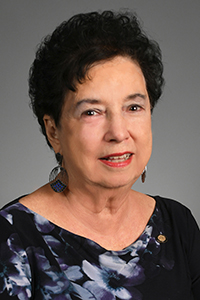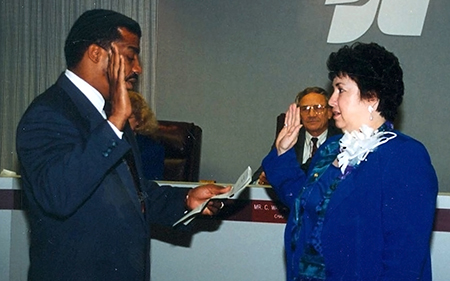A real joy Board chair reflects on San Jacs challenges changes during her tenure
"That's it!"

Marie Flickinger didn't say those words, but she thought them as she huffed out of the Friendswood newspaper office.
Her crusty editor had nitpicked her Little League photos for the umpteenth time. That day in 1975, she decided to prove him wrong.
And prove him wrong she did. One year later, Flickinger founded the South Belt-Ellington Leader paper. From covering the San Jacinto College South Campus groundbreaking to establishing the local chamber of commerce and uncovering the toxic Brio Superfund site, she became a community fixture.
In 1995, Flickinger ran for San Jac's Board of Trustees. Twenty-six years later, she still maintains her seat.
As the College celebrates its 60th anniversary, the Board chair reflects on her history with San Jac — its challenges, successes, and future.
Q: How did your relationship with San Jac begin?
A: I knew about San Jac partly because of the newspaper. I used to do stories about San Jac. I had pictures of the South Campus groundbreaking, and I had pictures of Dr. Tom Spencer, the first Chancellor. We went on a tour of the initial construction, and I got to know him. He couldn't remember my name most of the time and called me "my friend with the newspaper."
Q: Why did you join the Board, and why do you continue to serve?

A: John Moon Sr. strongly encouraged me to run. Before that, I had worked on the Brio Superfund site heavily for about 10 years. When we were fighting the government and were successful, it meant [we had proven] something bad had happened: Kids had been exposed to chemicals and had birth defects.
With the College, when you work and something is successful, it means something good is happening for kids. I think that's why I've stayed with it so long — it's good to be a part of making people's lives better.
Q: How has the College changed during your time on the Board?
At a national conference in the 2000s, Flickinger and Trustee Dr. Ruede Wheeler saw San Jac's student success rate numbers and realized the College needed to move the needle.
A: The view years ago was: Did we have more students than the previous year? Then we were growing. Did we have enough money to pay our bills? Then we were doing well. Well, we were losing students, but we were replacing them with more students who were not going to succeed either. We have moved the figures up tremendously. Now everyone is on a real effort to see students succeed and complete.
With our maritime program, the Generation Park Campus, and the aerospace program, we're growing not just in numbers but also in our mission. We've also really grown the early college high school programs. For first-time-in-college students who can't afford UT or A&M, they can still go to San Jac and get a darn good education. Two weeks before getting their high school diploma, they're getting an associate degree.
Q: What challenges have you seen the College overcome?
A: A bigger challenge came before [changing the culture to student success]. We had three campuses: North, South, and Central. They competed with each other and didn't work together as one College. I remember when an industry wanted to work with the College, and the campuses were competing for it. The industry told us, "Until you can work together, we're not interested." That really changed things.
Today we are one College — San Jacinto College. It's hard to imagine now because it's so different today.
Q: How has San Jac evolved to meet community needs?
Because of changing student demographics and needs, the College eliminated all athletic programs except baseball and softball.
A: Our students used to be able to just be students, and it used to be that the College was really strong in athletics. After students got out of school, they were going to basketball games.
Things have changed. Now students are going home, working, feeding their families.
I think [eliminating some athletic programs] was a big change for those who remembered how fantastic our teams used to be. Now we're putting more emphasis on training people in our district for getting out and getting good jobs. That's been a change — one that's made us stronger because we have a better working relationship with industry. And students are better off because they're being trained for high-wage jobs.
Q: We're celebrating 60 years. What do you see for our next 60 years?
A: I think the College is going to keep growing in its outreach. I can't imagine what's going to happen in the next 60 years. Just see what's happened in the last 60 years. The internet, social media — who would have expected that 25 years ago?
Q: Why are you proud of San Jac?
A: In this crazy world today, there's a lot of cynicism about people doing things and doing them for the right reason. San Jac does its job for all the right reasons because we want students to be successful. You can't have any purer motive than that. We work hard to make sure students are successful. Our goal is to make lives better.
I've gotten to do a lot of things working with the community and the newspaper. The thing that has given me the most satisfaction has been serving on the San Jacinto College Board — the satisfaction of knowing we've made things better for students. It's been a real joy.
